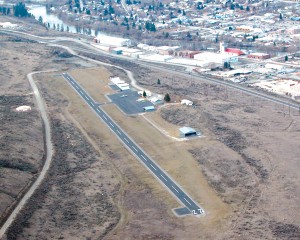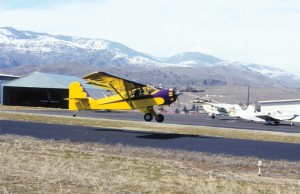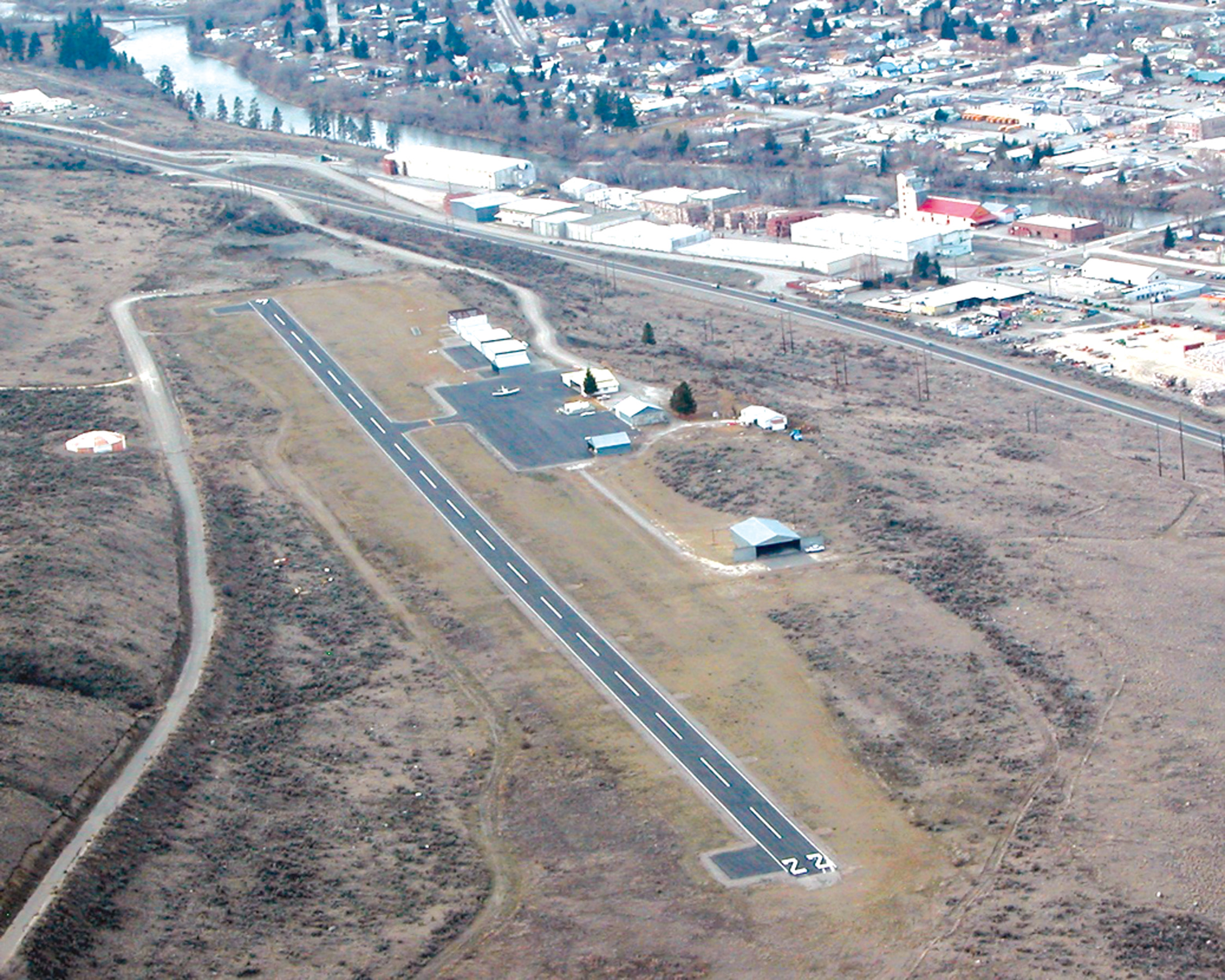By Terry Stephens

A group of local volunteers has taken over the reclamation and operation of Okanogan Legion Airport, saving the airfield from being abandoned and creating economic development opportunities for the community.
Thanks to a group of local volunteers, the almost abandoned Okanogan Legion Airport (S35) in north-central Washington has been saved. Instead of a being a deserted airstrip today, new hangars are being built, as many as 18 aircraft call it home, and an industrial park is being planned to create new jobs.
In fact, the volunteers’ efforts have been so successful that the Department of Transportation’s Aviation Division recently honored the municipal airfield as the state’s 2005 Airport of the Year for its years of continuous improvement.
How close Okanogan Legion came to being closed, and how it’s now having a positive impact on the town’s economy, is a turn-around story that was inspired by residents’ determination to preserve the community’s longstanding role in local aviation.
“People here see the airport as part of their identity. There’s a long history to it. Even before it officially became an airport in 1929, it was used in the early 1920s and probably even earlier,” said John Townsley, a member of the group that came together to restore the airfield.
The other motivating factor was economic development, which became the driving force to save the town’s airport.
“Several people thought abandoning the airport would be a mistake. If you look at the communities in Washington that are more stable than others, they have diversified transportation opportunities,” he said. “Every city among those with the top revenues has an airport.”
Okanogan, with 2,400 residents, is the second largest town in the county and also the seat of government for the state’s largest county, with 5,281 square miles and 38,400 people. No doubt about it, the group thought it was essential for their community to have an operating airport.
After nearly five years of promoting the airport’s recovery, the group decided it was time for a more organized effort. They formed the nonprofit Okanogan Airport Association, lobbied the city to keep the facility open and set up a management agreement between the city and the association for developing and operating the airport. Several in the group were pilots, including one who flew all over the world for Exxon Corp., and others who had flown for airlines or flew experimental or sport aircraft, Townsley said.
Under the agreement, the city would budget funds to help restore the airport and sign as the government entity to apply for economic development and aviation department grants. The volunteers were authorized to work on the airfield. Any revenues collected at the airport would go to the city’s budget. A part-time airport manager, Bix Rosenkranz, was hired, paid from a share of the airport fees and fuel sales.
Early on, the Department of Transportation provided grants for developing a new “airport layout plan,” later granting funds to engineer and reconstruct the airport runway lighting system. The volunteers—who contribute more than 1,000 hours a year of their time and muscle—borrowed equipment to fill cracks in the deteriorating runway.
“We’ve got an improvement board with five men on it who do the decision making on what they want to do,” said Rosenkranz. “Then they take it to the city council for approval and grant applications. By filling the cracks ourselves, and using a $43,000 aviation grant from the state to have a contractor to do the seal coating, we saved our (2,500-foot-long) runway, which was starting to come apart on us. Our new ramp area is twice as big as the old one, which was only an inch of asphalt on bare dirt. Every spring it got real bad. I can remember pulling a Cessna 182 out of the mud where it got stuck when the asphalt broke through. Now we have the proper base and maintenance. It’s a wonderful addition to the airport.”
As the airport facilities were reclaimed, the progress caught the attention of the business community, as well as local pilots. Four new private hangars were built and the city is working to replace the roof of one of its two municipal hangars to restore the condemned facility.
“We’ve also got two or three local mechanics who want to set up a shop at the airport when space is available,” Rosenkranz said. “And we’re putting in a new water line for hydrants that will allow us to build more hangars.”
Visitors who arrive at the airport, such as attorneys who need to visit the county courthouse, can now borrow the airport’s courtesy car.
“One of the pilots in town bought a car at an auction and donated it to the airport,” he said. “We paid him back through fundraising events, so we’ve got our courtesy car at the airport. We’re not trying to compete with Omak’s airport (nine miles away) but it’s more convenient flying in here now than driving from Omak. People are realizing that we’re getting more visitors and more use of the car.”
More interest is developing day after day, Rosenkranz said, adding that the next big task for the group is working on the runway lights.
“They were put in 20 to 25 years ago, but the buried power lines weren’t in conduit so we’re beginning to lose some of them. We’re got to figure out how we’re going to fix that,” he said.
“The airport manager works really hard for that (little) pay and the whole group puts in a lot of hours,” said Ralph Malone, Okanogan city treasurer and clerk. “It’s their hobby and we’re the beneficiary of their entrepreneurial abilities. …they’ve been diligent in applying to WSDOT’s aviation division for grants for maintenance and improvements at the airport. The city has played only a small role in signing as the (grant) applicant. They put the project together, fill out the applications, the city council endorses it and the mayor signs it; then they manage the project to get it done.”
Malone said the city’s limited resources make the volunteer group’s efforts indispensable, since they basically run and maintain the airport, including painting the stripes and markings on the runway and apron areas.

Four new private hangars, a restored runway and 18 locally based aircraft are among the signs of new life for the airport, named the Washington Department of Transportation Aviation Division’s Airport of the Year for 2005.
Innovation is a hallmark of the group. After receiving the $43,000 grant for the runway and taxiway sealing, which they had estimated at $37,000, they found a company who did the work for $22,000, so they returned funds to WSDOT. With $5,000 for security fences to protect the runway, the group contacted the Job Corps at nearby Curlew, 100 miles away, to do the work. With $3,800 for the fencing, the installation cost was only $1,000 for room and board for the corps workers during their stay in Okanogan.
“I can’t say enough good things about the cooperative relationship between the city and the Okanogan Airport Association. They’ve more than met us halfway and they’ve had open support from city hall and the staff,” Malone said.
Townsley agrees the arrangement has worked out well.
“We do whatever we can to support the city and show them how the airport can be a real benefit to the community. Once we got things started, it really snowballed,” he said.
He also credited Mack McIver, who recently retired from the WSDOT Aviation Division, for “working tirelessly to promote rural airport aviation,” including Okanogan Legion Airport.
The association’s next move may be to enlist the support of the Colville Federal Tribes, the neighboring Indian nation whose reservation entirely surrounds Okanogan and the airport.
“We’re hoping to partner with the tribes on something that would be very beneficial to us and them,” Townsley said. “That-government-to-government relationship is very important to us. It would give the tribes an opportunity to develop their economy, too, in novel ways as they help to develop the airport.”
For more information, visit [http://www.okanoganairport.com].











